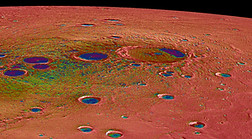
Volatiles on Airless Bodies
The poles of Mercury and the Moon both have evidence for water ice. I'm interested in the geologic histories of this water. Why are there meters-thick deposits on the innermost planet and only patchy frost detections on the Moon? Where did the ice originate from and how has it evolved?

Impact and Volcanic Processes
There is a distinct crustal thickness asymmetry between the nearside and farside of the Moon. I'm interested in coupling geologic and geophysical analyses to understand these asymmetries, to unravel regional impact and volcanic histories.

Seeing inside Shadows
Ice on the Moon and Mercury is often hidden within cold, dark shadows. I'm interested in using novel technologies, such as Neural Radiance Fields (NeRFs), to see inside these shadows, to enhance the safety and scientific yield of exploration.

Human Exploration
Humans are going back to the Moon, and then beyond. I'm interested in the tools, concepts of operations, and investigation strategies that enable astronauts to maximize science return during surface missions.

Hollow Formation and Evolution
Hollows are small sublimation features unique to Mercury that likely form when some volatile is lost to space. I'm interested in understanding their distribution and local environments to determine what causes hollows to form, grow, and eventually expire.
%20copy.png)
Instrument Design
Scientific instrumentation is the key to unlocking new knowledge about our Solar System. I'm interested in helping develop instruments to convert scientific questions into measurable data, especially related to multi-wavelength imagers, off-world drills, and other geophysical instruments.
“Exploration is in our nature. We began as wanderers, and we are wanderers still.
We have lingered long enough on the shores of the cosmic ocean. We are ready at last to set sail for the stars.”
-Carl Sagan